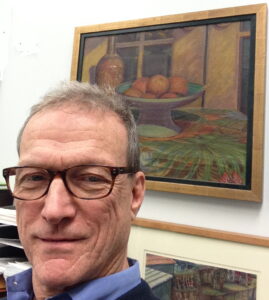Sheila Blake
![]() I’ve been a painter most of my life.
I’ve been a painter most of my life.
The same things that thrilled me when I first started to paint thrill me now: creating the illusions of space and light with paint. Looking at paintings – really looking – starts with the recognition that the artist held the brush and put on the paint. No matter how refined or active the surface is – the extraordinary illusions of Dutch still life paintings or the force of Franz Kline’s brush stroke – there’s still the power of the artist that made those paintings. Stand up close to a Van Gogh and you are transported to the moment that he put that paint on. Cezanne’s brushstroke, in its precise color, transforms before your eyes into atmosphere: a miracle; his still lifes are symphonies for the eyes and the mind.
During my short years in art school, I learned not only how to paint but what the pursuit of being a painter was about. My learning continues, and my teachers are all the artists that I’ve loved. Writing them all down would fill a book, but standing in front of the wonderful Bonnards at the Phillips Collection is one of my greatest pleasures. The way he structures his paintings in order to use color so freely – well, I’m beginning to absorb it. I love Richard Diebenkorn’s surfaces and Roy Lichtenstein’s mind, de Kooning’s big landscape abstractions and Edward Hopper’s composition.
I believe that there are unexplored paths that began with these painters and every day I am faced with reconciling the contradictions of the abstract expressionists which were at the heart of my training and the great representational painters of the past and present. This is what I love and teach and dedicate my life to.
Sheila studied at the Cooper Union Art School, 1957-60, and obtained an MA in painting from Goddard College, 1978. She taught at Duke University (1971-1980) and the Corcoran College of Art and Design (2003-2010).
Thomas Xenakis
 Born and raised in Brooklyn, Thomas Xenakis began his artistic career as a biological illustrator. In 1987 he entered into a personal quest to learn the techniques and materials of Byzantine art, including fresco, mosaic, egg-tempera, egg-oil emulsion, and wax encaustic. He began to write sacred icons, and was awarded a Senior Fulbright Fellowship to Greece in 1994-1995, which was followed by an artist-in-residency at the Wesley Theological Seminary Center for the Arts and Religion, Washington, DC.
Born and raised in Brooklyn, Thomas Xenakis began his artistic career as a biological illustrator. In 1987 he entered into a personal quest to learn the techniques and materials of Byzantine art, including fresco, mosaic, egg-tempera, egg-oil emulsion, and wax encaustic. He began to write sacred icons, and was awarded a Senior Fulbright Fellowship to Greece in 1994-1995, which was followed by an artist-in-residency at the Wesley Theological Seminary Center for the Arts and Religion, Washington, DC.
Thomas entered the Maryland Institute College of Art Hoffberger School of Painting in Baltimore, completing his degree under the guidance of Grace Hartigan, the renowned painter of the New York School. In 2000-2001, he was awarded a second Fulbright Foundation to research Greek outsider artists, which inspired a tenure in northern Greece producing a large and varied body of work in wax, oils, and graphite. In 2004 Thomas Xenakis had his first retrospective exhibition, Sailing from Byzantium, Twenty Years of Painting and Drawing, at the Visual Arts Center, Portsmouth Virginia. He participated in the 5th Florence Biennale of Contemporary Art in December 2005. He has for many years been working on sculpted and painted gilded panels in a series titled XPYSO (Gold).
Thomas taught painting, drawing, and design at Georgetown University in Washington DC, and at Marymount University in Arlington, Virginia, until his retirement in 2023. He is represented in collections throughout the United States, Greece, France, and Germany.
Peter Blake

As a graduate student and NASA engineer, I devoted many years to science. At the same time, being married to Sheila brought me a lifelong graduate training in art. Retired now, my new project is an immersion in poetry, philosophy, and art: all forms of thinking about questions that have no answers. Such thinking leads, I believe, to acting and experiencing our life more fully.
